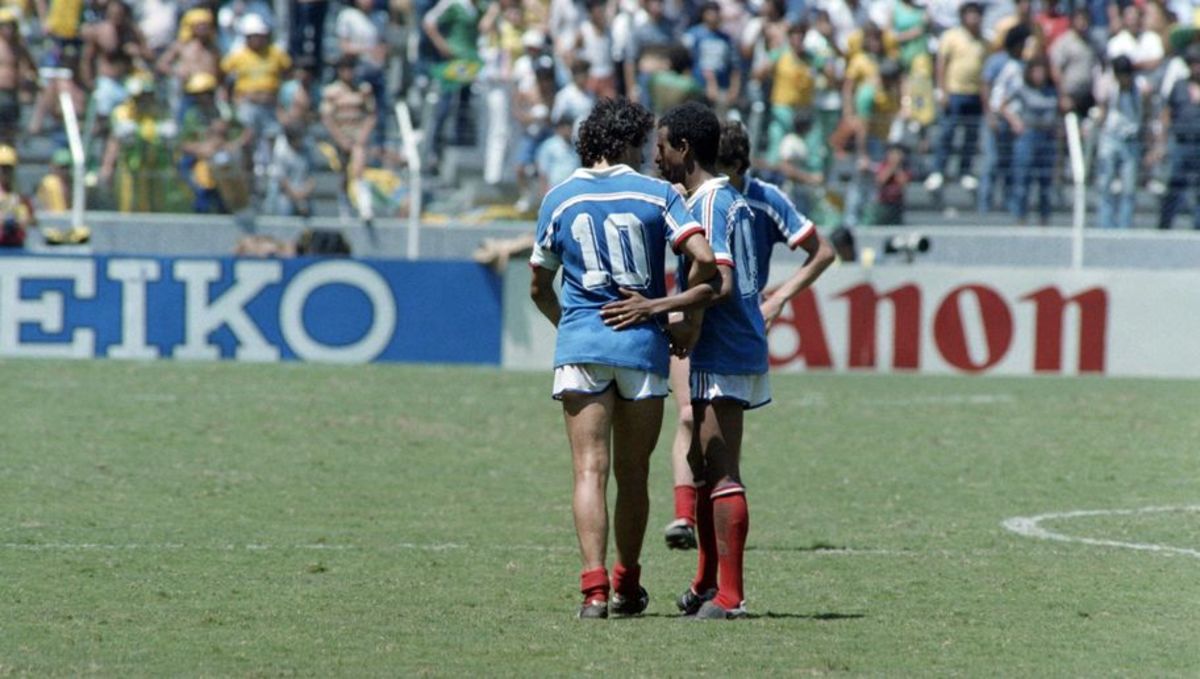World Cup Countdown: 9 Weeks to Go - France's Magnificent Midfield Quartet, Le Carré Magique

They say that good things come in threes: the Three Musketeers, the Three Little Pigs, the Three Blind Mice... you get the picture. Ideally, from fairytales to Hollywood blockbusters, the concept of a trio is the most effective. Having said that, in the case of the French national team between 1982-1986, it was not three, but four that captured the imaginations of thousands.
It was Michel Platini, Jean Tigana and Alain Giresse to begin with, and to prove the aforementioned point, a good thing did come in a three. The trio caused havoc in the Spanish summertime of 1982, leading their county to the semi finals where West Germany would stand in their way of an appearance in the final.
However, despite each of them scoring in the thrilling event, the Germans prevailed on penalties; good things do come in threes, but in the case of Les Bleus' World Cup campaign, that was all it would amount to. Not great, but good. As effective as the trio were, something was missing.
A chance at redemption rolled around just two years later for France in the shape of the European Championships, but this time, the formidable trio had another string to their bow...
Luis Fernandez had arrived on the scene; a player who had received his first international call up just months after the 1982 disappointment. It quickly became apparent that Fernandez was an exceptional ball winner, while he also possessed the ability to pass the ball incisively.
Now, the attacking talents of Platini, Giresse and Tigana - to some extent - had lacked such an anchor while at the World Cup in 1982. Their offensive abilities, despite being some of the best around at the time, lacked that protection behind them, meaning that if they were to put the ball at risk and lose it, the opposition could hurt them.
What Fernandez offered was such protection. The Paris Saint-Germain academy graduate screened his backline effectively and with commitment, meaning that those ahead of him could play freely and confidently without worrying about the potentiality of danger behind them. Contextually, for the modern game, Fernandez offered what N'Golo Kante offers today.
With that final piece of the jigsaw came a sense of identity to the national team. As Brazil were recognised through Pele, the Dutch recognised by Johan Cruyff and an innovative playing style, the French were now symbolised by Le Carre Magique - the magic square.
The quartet became the talk of opposition dressing rooms. 'How can we get past Fernandez?' 'Can we man mark Platini?' 'Won't doing that free up Giresse to hurt us?' When one of the fours could've been nullified, the others came to fruition and became more effective.
After two years of gelling together, Le Carre Magique could finally put their abilities towards some competitive actions as the European Championships rolled around. Eager to avenge themselves after the heartbreak of 1982, the French were raring to go.
The host nation topped their group effortlessly, winning three out of three games, scoring nine and conceding just twice.
Platini, owner of the iconic number 10 shirt and the captain's armband, was perhaps the most grateful beneficiary of Fernandez's arrival. This statement all the more vindicated by the forward's seven goals in just three group games alone.
Les Bleus' captain would finish the tournament as top scorer, having found the back of the net on nine occasions, including an 119th minute winner against Portugal in the semi finals to give France a shot at redemption in the final.
Rather fittingly for the most iconic player in that era of French football, Platini scored the opening goal in the final against Spain with a low driven free kick to all but win the tournament single handedly. Bruno Bellone's stoppage time goal in the same game being more of an icing on the cake moment than a telling contribution.
Rather unbelievably, Platini managed to net his nine goals in just five games at the European Championships that year, although he couldn't have done it without the rest of the quartet.
Giresse and Fernandez also managed one goal each at the tournament, whilst Tigana's midfield dynamism gave the side great energy and desire to compete against Europe's best.
Some eras are defined by just one player. An icon of the times, if you will, but this era belonged to Le Carre Magique. The balance in that legendary midfield four proved inspirational for teams in later years and is still adopted today.
All of the sadness and dejection that the West Germans caused back in '82 had been washed away by the final piece of the jigsaw slotting in seamlessly. If the trio of Tigana, Giresse and Platini had been the exciting Jenga tower resting on just one block before collapsing, Fernandez was the ultimate rebuilding of the tower and the beginning of another match. For while the game still proved exciting, the foundations beneath them had strengthened, as had the pride of a colossal footballing nation as they witnessed their team gain an identity in the game thanks to Le Carre Magique.





